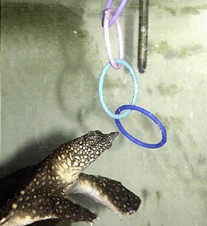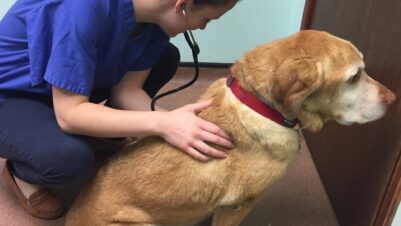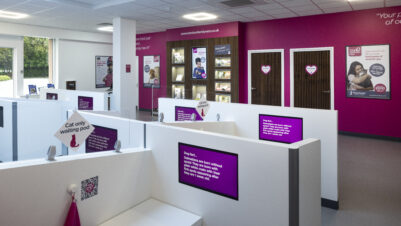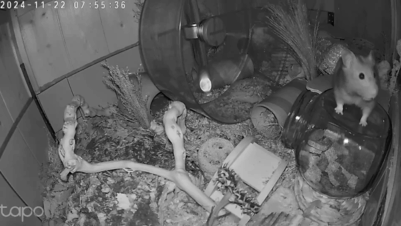It is well known that a visit to a veterinary clinic is a stressor for the majority of our patients. Every veterinary professional has experience convincing dogs to stand on the scales or convincing feline patients to come out of their carriers. However, this stress is often not considered for our exotic patients.
As most exotic pets are prey animals, transport to unfamiliar places is often met with a severe increase in stress, especially for avian patients who are very intelligent. In addition, the journey to the vet is commonly the only time avian patients leave the house and are transported in carriers.

Stress in avian patients
Birds are highly intelligent and often very neophobic of new environments or experiences. By the time an avian patient reaches the veterinary clinic, it is usually already experiencing levels of stress, which are often compounded if the patient is unwell.
Many birds have never experienced car journeys, and unless training has been carried out by the owner, many are unfamiliar with and untrusting of the carrier or container for transport.
Stress can exacerbate disease syndromes, and in patients exhibiting a prey response and attempting to appear well when they are unwell (for example, sham eating or preening), acute stress can be enough to push patients over the edge, resulting in cardiac arrest.
Signs of stress
Signs of acute stress in birds can be subtle but commonly manifest as vocalisations (such as shouting or hissing; Video 1), lunging or trying to bite, panting, flapping or turning over into dorsal recumbency on the bottom of the cage.
Birds may also show signs of “eye pinning”, where the pupil is rapidly dilated and contracted, lean away from unknown humans or items (Figure 1), freeze or engage in displacement behaviours, such as toe chewing (Fear Free LLC, 2022).
Physiologically, acute stress can result in tachycardia, tachypnoea, hyperglycaemia and the elevation of circulating corticosterone (Blas, 2015).
VIDEO (1) A Goffin’s cockatoo hissing at a perceived threat. This noise is not uncommon in cockatiels and cockatoo species and should not be mistaken for respiratory disease
Minimising stress for the avian patient in veterinary practice
In an ideal situation, the client has educated their bird on handling and travelling. This means they have spent time training them to enter and travel in a carrier, be handled by strangers and, in the best-case scenario, tolerate towelling and medication administrations. However, this is rarely the case, so any veterinary staff member examining an avian patient, whether a pet or wild bird, should attempt to do so in a way that elicits as little stress as possible.
Before the examination – environment and acclimatisation
First, attention should be turned to the area where the bird will be examined. The ideal space is quiet and secluded, has low foot traffic (Lightfoot, 2000) and should be away from any predators. Ideally, the room would be small to prevent panicked flight and have no open windows or small spaces a patient could escape through. Avian patients are unique in their ability for flight, which means they can attempt to evade veterinary staff vertically and horizontally and will often attempt to escape a stressful stimulus.
As long as the patient is stable, the carrier should be placed on the table upon entering the room, and a history taken from the owner while the bird is contained. This allows the bird to observe the room while remaining in the relative safety of the carrier. It also allows the veterinarian to observe “hands-off” behaviour, such as respiratory effort and energy level.
Following history taking, the carrier door can be opened, and the patient invited to exit the carrier at their own leisure (Video 2). Some birds have already been trained to respond to a “step up” command at home or will step up onto their owner’s hand or a wooden perch if they are reluctant to leave the carrier. Forcefully removing the patient with a towel or gloved hands is not a fear-free approach and should only be performed as an absolute last resort. Birds approached in this manner may panic and injure themselves while trying to escape, especially if limbs are trapped through the bars of cages.
VIDEO (2) An African grey parrot invited to leave the carrier of her own accord for examination. Note that when the patient begins to step out of the carrier, it is disturbed by the entrance of new people into the room and immediately retreats, demonstrating the need for a quiet examination room that is not used as a thoroughfare
Swooping over the top of a bird and catching it over the back with a towel is often referred to as the “harpy eagle catch”, imitating how a bird would be caught by another avian predator in the wild (Welle and Wilson, 2006), and is not recommended. If towel restraint cannot be avoided, the recommended approach is the frontal towel approach, where the bird is held in the same hand as one corner of the towel. Then the towel is brought from underneath the bird, up and over the shoulders and the head (Welle and Wilson, 2006). Following this, the patient can be loosely restrained in a towel, allowing the keel and ribs to move unencumbered to prevent suffocation (Figure 2).

When performing any examination or procedure around the head or upper body of a restrained bird, the head of parrots or birds of prey should be gently held to prevent injury to the handler. Towels are versatile, soft and useful to contain flapping wings, and give the patient something to grip with their feet. Prior training to accept towels with the owner can result in a patient who is happy to be gently restrained in a towel for physical examination with minimal stress (Fear Free LLC, 2022).
Once out of the cage, the bird should be given the space to interact with its surroundings and become accustomed to the room. If general anaesthesia is not required, food-motivated birds can be distracted by novel or high-value food items (Video 3). Birds can also explore the examination room and interact with items if it is safe to do so (Video 4).
VIDEO (3) A juvenile blue and gold macaw provided with small pieces of apple to allow him to acclimatise to the examination room and distract from any potential adverse stimuli
VIDEO (4) During a consultation, this blue-fronted Amazon parrot was attracted to the running water while a staff member washed their hands. Allowing the patient to interact with stimuli in a positive way encourages the patient to be calm and reinforces that veterinary visits do not need to be stressful or scary
During the examination – handling and interaction

As part of the examination, the bird’s weight should be measured. The type of scale used to weigh the patient can be very important, as birds will be mistrustful of a scale if it makes them feel unsafe. The ideal set of scales will be low to the ground, have a low centre of gravity, have a non-slip surface, have no obstacles and must be an appropriate size for the patient (Fear Free LLC, 2022; Figure 3). Perching birds such as parrots or birds of prey may appreciate the provision of a perch on top of the scale to facilitate weighing as long as it is stable and does not wobble on the scales.
Some birds are more accepting than others of physical examination (Video 5). Particularly conscientious owners may have even trained their birds to accept examination before requiring a veterinary visit. The author prefers to conduct a slow, stepwise examination to allow the patient to become accustomed to being touched by a stranger.
VIDEO (5) An African grey parrot allowing examination of the axillary area under the wings. Because lifting a wing allows exposure of the body, it is not always tolerated if a patient is untrusting of the person performing the examination
It is useful to have all examination items, such as the stethoscope, otoscope, etc, already out and in sight of the patient before conducting the examination, so as to not introduce new things during the proceedings (Fear Free LLC, 2022). It is important to be patient and allow the bird to become accustomed to each step of the physical examination. If pushed over their stress threshold, a bird may lunge or bite, at which point the person conducting the exam should take a step back and return to the last step the bird tolerated.
Each bird will have an established tolerance level for the amount of interaction they will accept during a veterinary visit. This is often based on prior experience, owner training and their personal level of tolerance for novel experiences. With time and training, some birds will accept routine procedures, medication administration and, in some cases, blood sampling with minimal or no restraint (Videos 6a and 6b).
Some birds are more comfortable when able to hold something in their feet or beaks (Fear Free LLC, 2022) (Video 7).
VIDEO (6a) A blue-fronted Amazon parrot accepting the use of a high-speed Dremel to file down his sharp nails with minimal restraint
VIDEO (6b) The same blue-fronted Amazon parrot accepting a high-speed Dremel to perform beak shaping with only gentle restraint. This patient was accustomed to the loud noise and vibrations from the Dremel and had learned through previous experience that this was a procedure he was willing to tolerate
VIDEO (7) While any toy given to a parrot during examination should be non-toxic and not easily swallowed, this eclectus parrot was drawn to the heparin blood tube due to its bright colour and was happy to sit playing with this until the next phase of his examination
Housing for hospitalisation
If an avian patient is required to stay in hospital, housing requirements should be considered. All avian patients, regardless of species, should be housed separately from predators and loud animals – barking dogs, for example. A quiet, warm ward with minimal foot traffic is ideal.
Parrots require robust cages and surfaces to perch and hold on to. Passerines and domestic fowl can be placed in flat-bottomed cages where they can stand and forage around.
Parrots in particular are very social creatures, and many are unaccustomed to isolation. Frequent positive interaction not only comforts parrots who are not fearful of strangers but also reinforces the idea that not all interactions in a veterinary setting are negative (Video 8).
Cages should contain areas to hide, and ideally (in patients that are not too unwell) provide the ability to engage in enrichment (Video 9).
VIDEO (8) A scarlet macaw accepting attention and allopreening while hospitalised for treatment. This positive reinforcement means that patients will not be fearful of a negative stimulus when someone opens the cage door
VIDEO (9) A green-cheeked conure playing with a hanging toy while in hospital
Accepting medication
Birds can be trained to accept medications directly from a syringe. Ideally, this training should occur before medications are required. The author provides syringes to all bird owners presenting for general health checks to allow the introduction and investigation of syringes at home while the patient is healthy.
Providing a syringe of unsweetened fruit juice or puree can teach a bird to accept liquid from a syringe. Other birds will accept food, such as hand-rearing mixture, from a syringe, with medication provided mixed in or alongside the food (Video 10).
VIDEO (10) An African grey parrot accepting food from a syringe, with medication delivered intermittently, following beak surgery. This patient accepted all medications provided in this way, as the liquid food was a high-value treat for her
Conclusion
Avian patients often do not visit veterinary clinics until they are unwell. Poor tolerance for new experiences and environments and high intelligence mean avian patients are often stressed before arriving at the veterinary clinic.
Owners can help prevent stress associated with veterinary visits by teaching their pets to tolerate examination and towelling and accept liquids from a syringe. Veterinary staff can reduce stress by practising minimal gentle restraint, being patient with the progression of an examination and providing positive stimuli and enrichment during hospitalisation.











